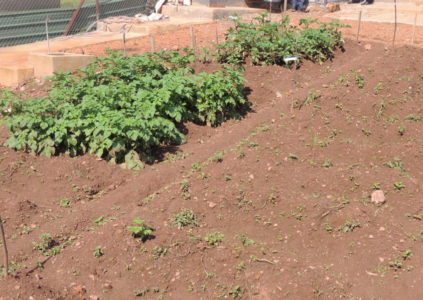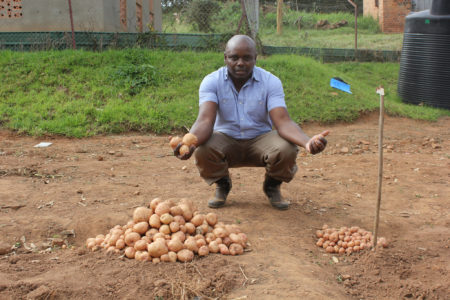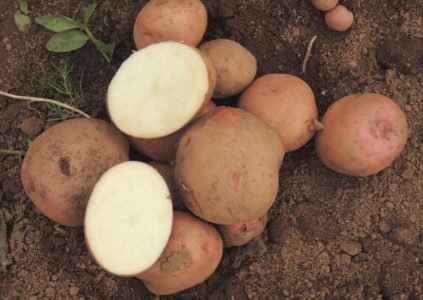
Late blight disease is a major constraint for potato production in sub-Saharan Africa, causing an estimated 15 – 30 percent average yield loss on smallholder farms. In the East African country of Uganda, where about 300,000 smallholder households grow potatoes for subsistence and income, late blight can destroy as much as 60% of a farmer’s potato crop, which translates into annual losses of approximately $129 million.
Although farmers commonly use fungicides to control late blight, those agrochemicals are costly and the pathogen gradually adapts to them, making them less effective. Fungicides also pose potential risks to human health and the environment. However, a better solution for lateblight is in sight.
A new study, published in the journal Plant Biotechnology, reports that the transfer of three resistance (R) genes from wild potato relatives into cultivated potato varieties provided complete resistance to late blight for several seasons. The study, conducted by the International Potato Center (CIP) and the National Agricultural Research Organization (NARO) of Uganda, also suggests this resistance will be long lasting.
Transferring resistance into popular varieties

Scientists chose ‘Desiree’ and ‘Victoria,’ which is one of the most popular potato varieties in East Africa, for genetic transformation. The goal was to develop potatoes with durable resistance to late blight by transferring three resistance (R) genes from potato wild relatives – what is referred to as the 3R-gene stack – into widely grown varieties. While late blight resistance has been transferred from wild relatives into cultivated potato through conventional breeding, the process is extremely slow and the resulting varieties have not been widely adopted.
This process offered the possibility to produce multiple lines from the same variety with different combinations of resistance genes from wild potato relatives without changing the intrinsic properties of an already popular variety. ‘Desiree,’ a red-skinned potato that matures in about 4.8 months and yields between 30 to 40 tonnes per hectare is widely grown in Kenya, but very susceptible to late blight. ‘Victoria,’ which was officially released in Uganda in 1992, is a farmer-preferred variety that matures in about three months and yields 35-45 tonnes per hectare. Its large, pink-skinned potatoes are popular with consumers in Uganda and neighboring countries, but it also requires regular fungicide applications to protect plants from late blight.

Following the successful transfer of the 3R-gene stack into ‘Desiree’ and ‘Victoria’, scientists tested the resulting plants in confined field trials – in compliance with national regulations – at NARO’s Kachwekano Zonal Agricultural Research and Development Institute (KaZARDI), in southwestern Uganda. They were exposed to high late blight pathogen (Phytophthora infestans) pressure, due to the KaZARDI station’s high humidity and low temperatures (14 – 25 °C), during two rainy seasons (Oct. – Jan. & March – June). In all cases, the plants with the 3R-gene stack were grown alongside the Desiree and Victoria varieties without any use of fungicides. While the Desiree and Victoria plants were destroyed by late blight disease, the versions of those varieties with the 3R-gene stack thrived, producing potato yields that were four times higher than the national average.
The results of this study offer hope for Uganda’s smallholder potato farmers, who spend a significant portion of their earnings on fungicides or face the threat of loosing their entire crop. The late blight-resistant, biotech potato will reduce the costs and health risks associated with fungicides, which means more money in farmers’ pockets.
This research is funded by U.S. Agency for International Development (USAID) and 2Blades Foundation.
Blog by Vivian Atakos and Marc Ghislain. Editing by David Dudenhoefer.
